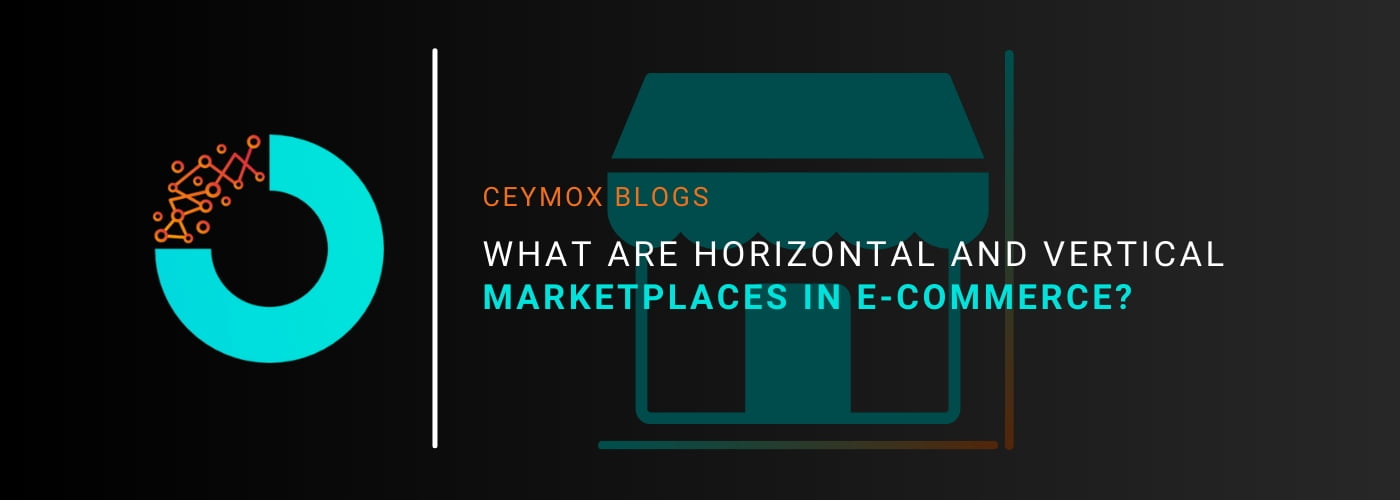
The marketplaces have always been the core focus of the e-commerce industry with millions of people buying products regularly from popular marketplaces such as Amazon, Flipkart, Target, etc. These marketplaces have become the go-to platform for buyers and sellers to connect and make transactions. However, we as buyers or even sellers consider marketplaces as only a single type, but different types of marketplaces cater to various demands in both vertical and horizontal markets. In this article, we will go understand horizontal and vertical marketplaces, and how they differ from each other.
What is an Online Marketplace?
An online marketplace connects three different entities on an e-commerce platform: sellers or online merchants, customers, and administrators. You can categorize the marketplaces on different basis, such as:

Whether you are involved in B2B, B2C, or C2C business, you can decide whether you want to develop a horizontal or a vertical marketplace for your business. As a top-notch e-commerce development company, we will explain the concept of these marketplaces and their differences.
Horizontal Marketplaces: Get everything in single place.
At horizontal marketplaces, customers can find and buy everything in a single place. A horizontal marketplace allows the combination of markets with retailers of varied industries in a digital one-stop platform for a wider coverage of audience needs.
The best example of a horizontal marketplace can be Amazon. At Amazon, you can buy almost anything you could think of. The company began its journey as a bookseller, but now it has more than 2 million sellers in different industries. Amazon functions as both a platform and a vendor; in addition to its own products, third-party shops are highlighted here.
We always recommend horizontal marketplaces for businesses which are small or medium-sized, or startups which have financial constraints. That’s why, temporary or permanent collaboration with other companies can allow them to create a presence in the market or utilize the shared resources in the best way to generate profits.
A horizontal marketplace is defined as one that combines multiple market segments and follows a varied marketing approach, with both advantages and disadvantages.
Benefits and Limitations of the Horizontal Marketplaces:
While thinking of launching a marketplace, it is always required to understand its strengths and weaknesses. For a successful horizontal marketplace development, a highly sophisticated marketing strategy is required and you have to resolve a plethora of tasks at the same time. One of the major advantages of horizontal marketplaces is that they can meet almost every customer need. As they cover a huge range of retailers from varied industries without going to multiple different sites. However, although horizontal marketplaces aim to cater to varied customer requirements, they face cut-throat competition from vertical marketplaces whose focus is on specific industries. Let’s understand the advantages & limitations of horizontal marketplaces:
Advantages or Benefits of Horizontal Marketplaces:
1. Convenience:
Customers get a high level of convenience at horizontal marketplaces, as they don’t have to visit numerous sites for their orders. They get access to various products and services without the need for extensive research.
2. Choice:
With the availability of a large number of options, the customers also get more choices. Whether they want apparel, electronic items, home décor, shoes, etc. they can find them all at a single place.
3. Price Comparison:
It becomes easy to compare prices for the buyers and choose the best option that fits their budget. Since there are a huge number of sellers with similar offerings, they have to showcase differentiation by providing competitive prices and better deals.
4. Higher Market Share:
The economies of scale can be achieved by attracting vendors from different industries which further increases the market share and in turn, profits.
5. Increased Visibility:
Due to their enhanced visibility, sellers may reach a wider audience of buyers by using these huge platforms.
Other benefits of horizontal marketplaces:
- High transparency in pricing and product information
- Improved customer service and support
- High convenience with ease of shopping
- Opportunity for small businesses to compete with enterprise-level companies
Limitations of Horizontal Marketplaces:
Horizontal marketplace development is an effective strategy, but as with any process, it also has certain disadvantages which you must be aware of.
· Legal Issues:
If there are changes in legal regulations in certain industries then it may affect the whole marketplace and even the company’s future. Furthermore, alterations in technology that impact the way the service is used in vertical business could pose a risk to its profitability.
· Acquisition Costs:
Since marketing efforts are not for a single industry, the acquisition costs for converting a customer typically get high.
· A closer interaction:
Vertically oriented companies have better interaction with their customers due to limited offerings and high personalization opportunities. That’s why a supplier has strong on both parties and any organizational changes, despite having an ideal replacement, can result in a significant loss of resources and time.
· Standard offerings:
There are highly limited opportunities for cross-selling in horizontally oriented marketplaces to the existing customer base.
· Low product differentiation:
In a horizontal marketplace, there is always a threat to low products from new entrants from vertically focused companies of the same segment, and new horizontally focused entrants offering similar products at lower prices.
· Higher promotion costs:
Although there are a lot of benefits of a horizontal marketplace such as covering multiple industries and a wide range of audiences, developing and growing such a marketplace isn’t a cakewalk. Deep pockets are required for high promotion costs to get a competitive edge in the market over existing players.
· Dilution of Brand Identity:
Since there is a huge range of products and services offered by various sellers in the horizontal marketplaces, there are high potential risk of diluting the brand identity. When customers visit these marketplaces, they may get overwhelmed by the countless brands and products. This can result in excessive exposure due to which the business may not be able to create a strong brand presence.
Vertical Marketplaces: Conquering a Single Marketing Scope.
Contrary to horizontal marketplaces, Vertical marketplaces focus only on a single industry or market. Although, there can be a large number of vendors they must be from a single industry such as apparel, shoes, etc. When you have a marketplace that caters to only a single industry, you become the leading company in that industry. Generally, vertical marketplaces don’t have any backup revenue sources to keep the business alive.
A good example of a Vertical marketplace could be Myntra which is a leading apparel marketplace and caters to mostly clothing brands. By trying to be the best in its domain, a vertical marketplace limits its audience but ensures that offers every product of that industry. It keeps its position right in the audience limitation.
Benefits and Limitations of the Vertical Marketplaces:
The Vertical marketplace is a specialized marketplace that boasts a lot of benefits to the businesses operating in specific industries. Let’s understand why vertical marketplaces are highly popular and how they are beneficial for both sellers and buyers:
Advantages or Benefits of Vertical Marketplaces:
1. Specific Targeted Platform:
The main benefit of a vertical marketplace is that it can meet the unique demands of particular industries. By giving attention to a specific sector, these marketplaces offer specialized services for meeting industry-focused requirements. For instance, there are dedicated marketplaces for industries like healthcare, food, real estate, fashion, and automotive.
2. Connect with Localized Partners:
You can connect with relevant suppliers, vendors, and partners through vertical marketplaces. By bringing multiple players in the same industry, vertical marketplaces create an ecosystem where businesses and customers can find whatever products or services they require. This doesn’t only streamline the procurement process but also fosters collaboration and innovation within the industry.
3. High Trust and Credibility:
Vertical marketplaces have high measures of quality control and that’s why only authentic and genuine sellers get access to these marketplaces to sell. This helps in building trust among the buyers who can rely on the sellers’ credibility and product quality they are buying on these marketplaces. There are also ratings and reviews of each seller and product on these marketplaces to foster trust.
4. Lower Competition:
There is less competition in the vertical orientation of a marketplace because a vertical marketplace serves a particular industry niche with which other marketplaces find it difficult to compete. This decreased competition in vertical markets can increase sales and result in faster and better growth.
5. Streamlined Marketing Campaigns:
As there is a specific target audience of a vertical marketplace, it becomes easier to target this particular audience. The marketing campaigns give faster results and are less expensive.
Limitations of Vertical Marketplaces:
Despite having so many benefits of vertical marketplaces, there are also demerits that you must be aware of. Here are the limitations of the vertical marketplaces:
· Limited Product Options:
The foremost disadvantage of a vertical marketplace is that it offers a limited range of products vis a vis a horizontal marketplace. For e.g. on a healthcare marketplace like 1mg you may not be able to find skincare items while on a horizontal marketplace such as Amazon, it may have some generic OTC medicines.
· Smaller Customer Base:
Just like the limited product offerings, the customer base of a vertical marketplace is also quite small in comparison to horizontal marketplaces. The target audience is narrower in a particular industry.
· Can’t scale up easily:
Although specialization is beneficial for providing tailored solutions within an industry, it also limits growth opportunities. Vertical marketplaces may find it more difficult to diversify their product offerings or enter new markets than their horizontal counterparts.
· Potential Risks:
Operating in a certain business or niche also carries some threats. Vertical marketplaces are vulnerable to industry-specific developments or disruptions. For example, an economic slowdown or technical breakthroughs that render particular products outdated may have a huge impact on the marketplace’s viability and profitability.
Other cons of Vertical Marketplaces:
- Costly in comparison to general marketplaces
- Less competition among sellers
- Difficulty in finding specific products
Differences Between Horizontal and Vertical Marketplaces:
Till now, you must have understood that horizontal marketplaces cover a high variety of products and bring together sellers of multiple industries. On the other hand, vertical marketplaces focus on a particular industry and have a niche or say every product of that industry. Both these marketplace types are essential for connecting buyers and sellers. Here are the differences in brief in these marketplaces:

Which is the right marketplace model for you? Horizontal, Vertical, or Global?
There are multiple factors to evaluate while identifying the right marketplace model. The nature and scope of your business play an integral role in identifying which marketplace would be suitable for you. Understanding the preferences of your target audience along with their buying behavior is another crucial aspect. Lastly, the evaluation of competition and potential for growth in each marketplace model is important.
Wrapping Up:
In this article, we have understood the concept of different marketplace types and how do they differ from each other. Marketplaces are a trending business model in e-commerce that connects buyers and sellers who are interested in transactional activities. A marketplace has the next-level features of a basic e-commerce store. Thus you require an expert-level e-commerce development company for building a marketplace whether horizontal or vertical. At Ceymox Technologies, the best e-commerce development company in India, we have a highly experienced team of developers, designers, QA experts, and consultants, who can build an advanced-level marketplace for you with trending features and functionalities. Let us know your requirements.
 Hubspot SEO Certified |  Hubspot SEO II Certified |  Google Ads Search Certified |  Google Analytics Certified |
Sreehari N Kartha is a skilled Digital Marketing Analyst at Ceymox, certified in SEO. His expertise encompasses a wide range of digital marketing strategies, including managing advertising campaigns on platforms like Google Ads, Facebook Ads, Instagram Ads, WhatsApp Ads, and LinkedIn Ads. With a strong foundation in SEO and SMM, Sreehari is adept at optimizing online visibility, driving engagement, and generating qualified leads and conversions. His passion for emerging technologies, such as Crypto, NFTs, and Web3, further complements his skillset, enabling him to navigate the dynamic digital landscape.
View All Articles








